Game, Set and Match II. Notes from Annet Dekker, curator at the Netherlands Media Art Institute: The New Art of Gaming, Or What Gaming can Learn from Installation Art.
Apparently the Netherlands Media Art Institute will organise in September a festival around gaming, immersion, interactive installations. If anyone ever has more details about it, plizz plizz, let me know.
Dekker explained how works of installation use interactivity and the function of the body. Her focus was on the relationship between art and computer games, or what computer games can learn from art (and in particular its connection to space, architecture, the body and interactivity.)
Since the arrival of Spacewars in 1962, little has changed. Today, many games are promoted for their “immersive qualities.” But waht do they mean by “immersion” in this context? Mainly life-like characters, better graphics and the use of new interfaces such as in Journey to Wild Divine, or Donkey Konga, for example. But even when players’ faces are integrated into the image on the screen or even when they are hooked up in some way to the game, one cannot say that players are really immersed.
If you want to step back in time, the early cinema also claimed to provide viewers with an “immersive experience”, so did the Italian opera.
Where in a game, the player needs a lot of concentration to get detached from the real world, in installation art, the player is immediately immersed in a different world. An environment is laid down that make new interaction models emerge in the virtual and the physical space, an environment designed by artists that reveals the new art of gaming.
Char Davies, Osmose, 1995-1996.
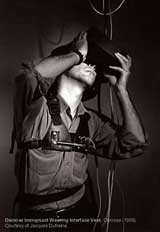
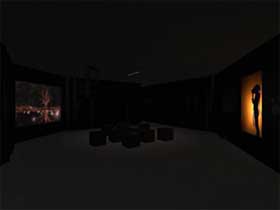
Immersion in Osmose begins with the donning of the head-mounted display and motion-tracking vest. The first virtual space encountered is a 3D grid which functions as an orientation space. With the immersant’s first breaths, the grid gives way to a clearing in a forest. There are a dozen world-spaces in Osmose, like Clearing, Forest, Pond, Subterranean Earth, Abyss, etc.
Through use of their own breath and balance, immersants are able to journey anywhere within these worlds as well as hover in the ambiguous transition areas in between.
Meanwhile, the audience can watch the choices that the immersant makes on a big screen and follow the immersant’s body move on the silhouette projected on a wall. Of course, the gear worn by the immersant looks bulky now. Today (ten years later) the technology would be more subtle and cheaper.
Text Rain by Camille Utterback and Romy Achituv.
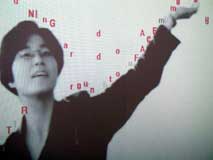
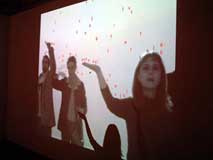
This installation engages people’s bodies, not just their eyes and fingers. In this dialogue between the physical and the virtual spaces, participants move their bodies to play with falling letters. On the screen they see a mirrored projection of themselves in b&w, combined with a color animation of falling letters. The letters respond to their motions and can be caught, lifted, and then let fall again. If a participant accumulates enough letters along their outstretched arms, or along the silhouette of any dark object, they can sometimes catch an entire word, or even a phrase. The falling letters are not random, but form lines of a poem about bodies and language. The role of body in communication is important.
Interactive Plant Growing (93), by Christa Sommerer and Laurent Mignonneau.
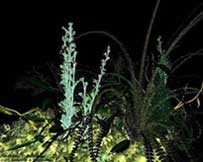
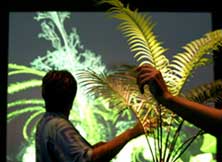
Human viewers can control the 3D real-time growth of virtual plants by touching real plants or moving their hands towards them.
Plant structures on the screen are programmed as plant-algorithms; they can develop and grow in 3 dimensions, rotate, scale, translate, deform and vary. The electrical potential difference between viewers and plants is directly transformed into electrical signals which conduct how the virtual plants grow on the screen.
The work shows how an interface can become an integral part of an installation and hence the experience.
Installation art has reflected a lot on how to break the barriers between virtual and physical spaces. By using natural interfaces or large architectural settings or complex spaces, many installation immerse the viewer in a different world. In the beginning of the ’90s, this was achieved by the use of dark spaces. Now artists return to real world spaces. This change is enforced by development in architectural design which is getting more fluid. Architects have begun to animate their work, hypersurface their walls, crossbreed different locations, etc. Example like Sky Ear, Scents of Space, Conscious Space (in which the only imput device is the body which acts as antenna) by Sonia Cillari and Muscle by Kas Oosterhuis mark a change that makes it difficult to distinguish architecture from art installations. There is a game-like structure in all those works.
Works by Blast Theory such as Desert Rain and Can You See Me Now make the connection between vitual and real world even more visible.
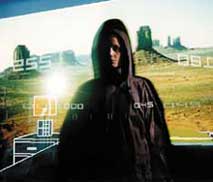
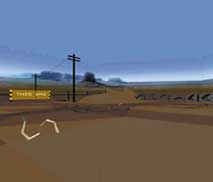 Desert Rain is a game + installation + performance. Desert Rain sends you on a mission into a virtual world. Standing on a footplate into a cubicle, each of the six team members explores motels, deserts and underground bunkers, communicating with each other within the virtual world. Players have 30 minutes to find the target, complete the mission, and get to the final room, where others may have a very different idea of what actually happened out there…
Desert Rain is a game + installation + performance. Desert Rain sends you on a mission into a virtual world. Standing on a footplate into a cubicle, each of the six team members explores motels, deserts and underground bunkers, communicating with each other within the virtual world. Players have 30 minutes to find the target, complete the mission, and get to the final room, where others may have a very different idea of what actually happened out there…
Can You See Me Now experiment with the convergence of online and offline worlds by using mobile technologies.
Ada the Intelligent Room , developed for the Expo 2002 in Switzerland.
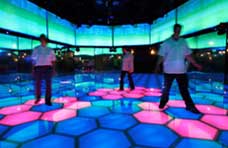
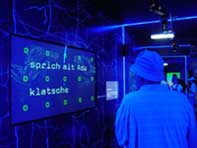
Ada, created by a team led by Paul Verschure, was a direct result of the link between physical and psychological realms. The room tries to make contact with visitors and communicate through sound, lights and visuals.
The examples from the history of installation art and recent developments in architectural design show show that there is much to learn for game developers interested in presenting games “outside the box” in terms of interface design, audience participation and the use of spaces. This is not to suggest that there are no interesting games at the moment, but…
If the gaming industry doesn’t pick up from this, in the end it will be left behind by the new art of gaming born from installation art and architectural design.
Related: From Paddles to Pads. Is Controller Design Killing Creativity in Video Games?







